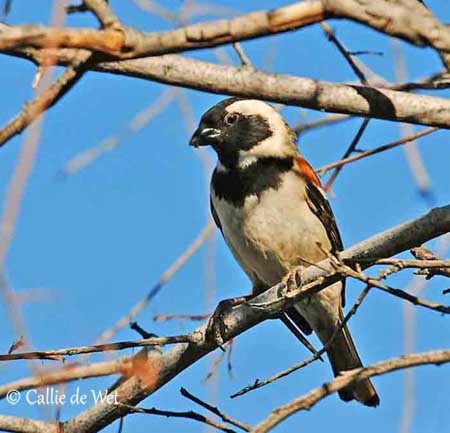
Fr: Moineau mélanure
All : Kapsperling
Esp : Gorrión de El Cabo
Ital : Passero del Capo
Nd: Kaapse Mus
Sd: Boersparv
Afrikaans: Gewone Mossie
Photographers:
Jean Michel Fenerole
Photos d’Oiseaux du monde
Ingo Waschkies
Bird Photography
Callie de Wet
Flickr Galleries
Text by Nicole Bouglouan
Sources:
HANDBOOK OF THE BIRDS OF THE WORLD Vol 14 by Josep del Hoyo-Andrew Elliot-David Christie - Lynx Edicions – ISBN: 9788496553507
BIRDS OF AFRICA SOUTH OF THE SAHARA by Ian Sinclair and Peter Ryan - Princeton University Press Princeton and Oxford - ISBN: 0691118159
ROBERTS BIRDS OF SOUTH AFRICA by G. R. Mc Lachlan and R. Liversidge – The Trustees of the John Voelcker Bird Book Fund – ISBN: 0620031182
BirdLife International (BirdLife International)
Biodiversity Explorer – The Web of Life in Southern Africa
Wikipedia, the free encyclopaedia
Cape Sparrow
Passer melanurus
Passeriforme Order – Passeridae Family
BIOMETRICS:
Length: 14-16 cm
Weight: 17-38 gr
DESCRIPTION:
The Cape Sparrow is found in SW Africa, usually in cultivated areas where it finds its favourite food, the large cereal’s seeds.
The adult male of nominate race has black head and upperbreast, except the white C-shaped band coming from the eye back to the nape, and then forwards to the lower throat’s side.
The upperparts are chestnut, including scapulars and lesser upperwing-coverts. The back is brownish. The upperwing is mostly dark brown with buffy margins. The median-coverts are tipped white. The greater coverts are finely tipped buffy and we can see a white patch at base of primary coverts.
The uppertail-coverts are grey and the tail is dark brown with paler edges.
On the underparts, sides are greyish whereas belly and undertail-coverts are whiter.
The bill is horn-coloured and become black in breeding plumage. The eyes are dark brown. Legs and feet are blackish-brown.

The female is duller but she has similar pattern. She has grey areas instead black, and the chestnut patches are duller.
The juvenile is similar to the female.
We can find three subspecies:
P.m. damarensis is found in extreme SW Angola, Namibia, W and E Botswana and extreme W Zimbabwe, and in N South Africa. This race is slightly smaller than nominate. The male has black head tinged brown and the female is paler.
P.m. melanurus (here described) occurs in SW South Africa.
P.m. vicinus is found in E South Africa and Lesotho. It is larger than nominate. The male has more glossy black head and the underparts are pure white. The female is darker.
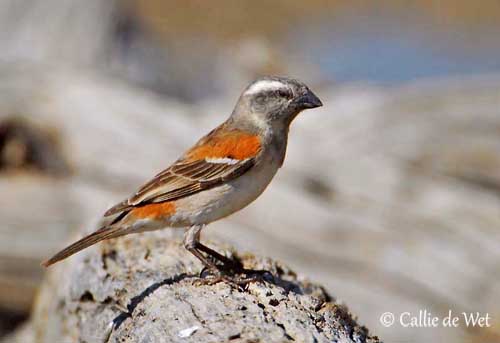
VOICE: SOUNDS BY XENO-CANTO
The Cape Sparrow utters series of musical cheeps alternating in pitch “chirp chroop, chipr chroop” or “chip, chollop, tlip, tlop, trreep”.
At nest, the male gives loud, far-carrying “tweeng” or “twilleeng”, sometimes changing into the jerky, repetitive previous song. The alarm call is a short, rattled “churr”. In flight, it utters some “chissip” or “chirrup”.
HABITAT:
The Cape Sparrow frequents grassland, fields and large gardens, and may be common in urban areas according to the range. It is usually found in semi-arid areas from open savannas with trees to light woodland, and not far from water.
RANGE:
See above in “subspecies”.
BEHAVIOUR:
The Cape Sparrow is a seed-eater, and feeds primarily on large seeds of grasses and cereals. It also consumes soft shoots and buds of plants, nectar and cultivated fruits such as grapes. During the breeding season, chicks are fed with caterpillars of Lepidoptera. Some insects are taken in flight, and their larvae are eaten too.
It needs to drink regularly and frequents water sources every day. It usually forages in trees and on the ground.
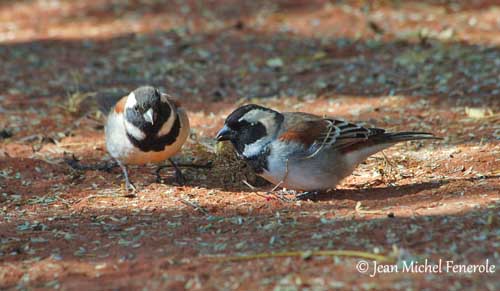
Outside the breeding season, they form small family groups, but also larger flocks up to 200 birds. They often occur around farmland and areas where they can find scattered grain.
They roost in nests all year round, and can be seen building nests at any season. They roost in single-species groups. They can be very conspicuous with birds flying around and calling before to perch at nightime roost.
During the breeding season, they breed in loose colonies of 50-100 pairs. They are highly territorial and can be aggressive.
Some displays have been reported, but they currently remain unexplained. They are probably closely related to breeding, or at least, to social bonding between members of a group.
Several birds of both sexes gather on the ground, close to each other. The head is held up while the tail touches the ground. Then, the group moves slowly along. Some birds hop irregularly, while others fly up and hover above the rest of the group, at 30-60 cm height. This behaviour lasts about 1-4 minutes, and then, they disperse progressively.
The Cape Sparrow is sedentary in urban and cultivated areas. However, it is nomadic in more arid regions where food resources are scarce.
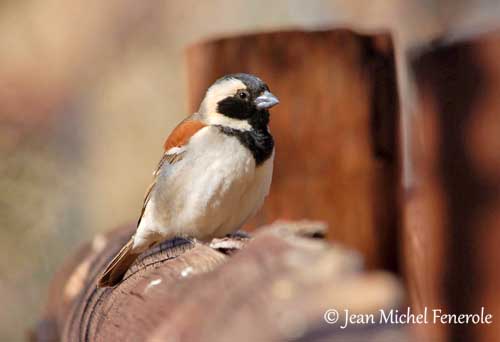
FLIGHT:
The Cape Sparrow is a good flier and performs strong wingbeats.
REPRODUCTION:
Reproduction depends on rains and insect abundance in arid regions, whereas the breeding pattern is more regular in cultivated areas. They produce one or two broods between October and February. They are monogamous.
The Cape Sparrow breeds in loose colonies and only a small population breeds solitary.
Both sexes build the nest, an untidy, loose, domed structure made with dry grass and twigs. The inner cup is lined with soft plant materials and feathers. There is an elongated side entrance.
The nest is placed high in canopy, often in thorny tree for better protection against predators. But some nests can be placed in creepers on walls, or hole in earth bank, and even in building.
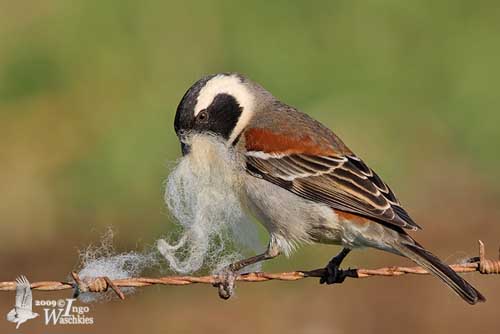
The female lays 2-5 white or greenish eggs with more or less darker markings. Incubation by both adults lasts 12-14 days. Both adults feed the chicks. The nesting period lasts about 16-17 days, but if the food is scarce, they fledge later, up to 25 days after hatching. They still depend on parents for 1-2 weeks after fledging.
DIET:
The Cape Sparrow feeds primarily on large seeds of grasses and cultivated cereals. It also takes soft shoots and buds, nectar and cultivated fruits, mainly grapes. Chicks are fed with caterpillars of Lepidoptera. Some insects and larvae are also consumed.
This species drinks regularly every day.
PROTECTION / THREATS / STATUS:
The Cape Sparrow has adapted to habitat changes and man-made structures and habitats.
The species is common to locally abundant throughout the range. Populations have increased in cultivated areas where it is becoming a pest, especially in wine-growing areas where it feeds on grapes.
But currently, the Cape Sparrow is not threatened.